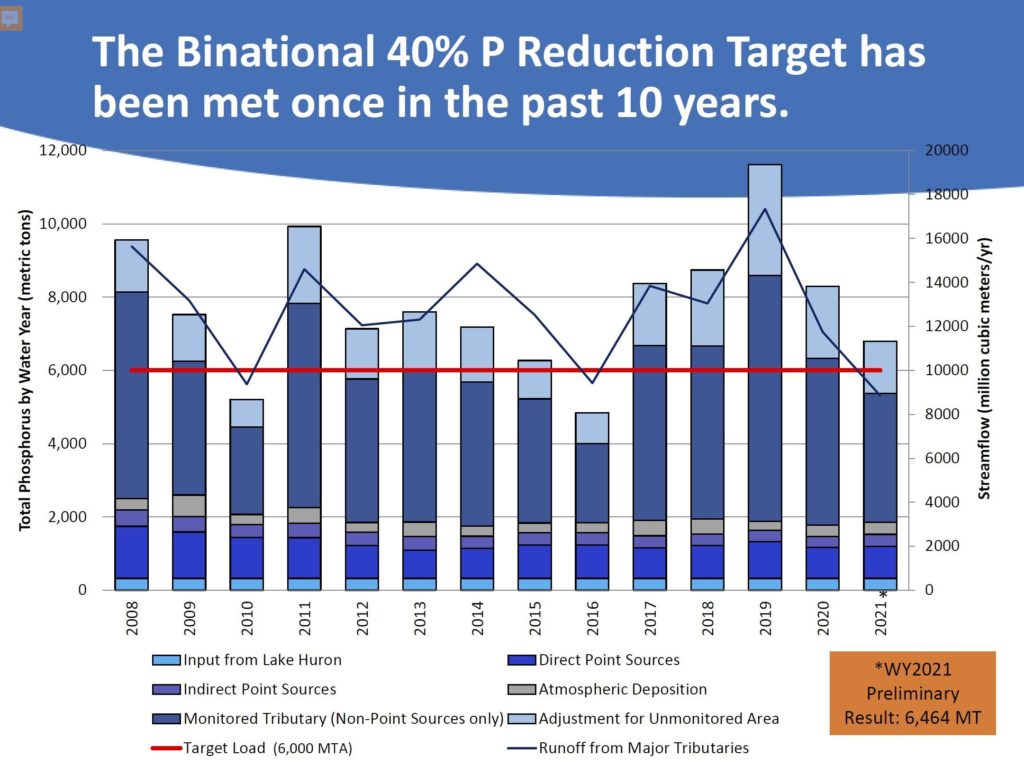
By Lester Graham, Michigan Radio
Federal, state and university researchers predict a smaller than average amount of harmful cyanobacterial blooms on the western end of Lake Erie this year. That’s chiefly due to long term forecasts of less rainfall, not a reduction in the pollution that feeds the blooms.
“We’re not expecting a large bloom because of our average to slightly below average discharge and loads,” said Richard Stumpf with the National Oceanic and Atmospheric Administration (NOAA).
Fewer storms means the volume of water in streams (the discharge) is not as great and that reduces the amount of nutrients (the load) carried to Lake Erie.
There are other factors that can affect the harmful blooms. Hot days can encourage the blooms to consume nutrients faster and increase the possibility of toxins. Wind direction can concentrate blooms and the toxins they produce.
Starting in 2008, the severity of the harmful blooms increased. It peaked in 2015, a year after Toledo, Ohio shut down its water system in an abundance of caution because toxins from the blooms were detected. Since then, the severity of the blooms has been up and down, primarily because of the variation in weather. Last year, the severity of the blooms was high compared to 2020. This year is expected to be less severe than 2021.

The severity of the harmful algal blooms in western Lake Erie are highly variable. (Graph by Lester Graham, sourced from NOAA data)
“While this year’s forecast is similar to the long-term average, the long-term average is not the goal,” said Don Scavia, an aquatic ecologist with the University of Michigan, in a news release. He added, “We cannot just cross our fingers and hope that drier weather will keep us safe.”
The consensus among scientists is that farms and other sources of phosphorus and nitrogen runoff must reduce the concentrations they apply and that ultimately get into surrounding streams that feed into Lake Erie.
An agreement between the U.S. and Canada set a goal of a 40 percent reduction in nutrient loading.
“We are not meeting the loading targets. No one disagrees about that. And there’s a lot of different factors that are going to be impeding our progress, including, you know, the climate, the land management, other factors,” said Santina Wortman with the U.S. Environmental Protection Agency.

A graph presented during a news conference by Santina Wortman shows the
agreement between the U.S. and Canada on reducing nutrient pollution has
rarely been achieved. (Image Credit: Santina Wortman / U.S. EPA)
The researchers agree the only thing that can be done is to reduce concentrations of the nutrients. That means getting farmers to apply less nutrient-rich fertilizer. On average, farmers have reduced application rates, but not enough to make a difference in the long run.
Researchers say wetlands are being established to reduce the flow of the runoff. And they’re trying to find ways to amend the soil to hold on to water longer.
NOAA offers a website which keeps track of the blooms. Anglers, recreational boaters and people who want to play in the water can get daily updates on where the harmful blooms are in Lake Erie.
The toxins from the blooms are dangerous.
“And so, please, keep yourself, your kids, and your pets, your dogs out of the water. There’s tragically every year, a couple of dogs in this country die by having swum in lakes with these kind of blooms,” said Stumpf with NOAA.
Catch more news on Great Lakes Now:
Study suggests phosphorous reduction alone could lead to more toxic algae
Harmful algal blooms cause problems in Lake Erie; drinking water customers pay the price
Great Lakes Water Authority monitoring Detroit River for algal bloom threat
Featured image: Lake Erie turns a bright green as toxic cyanobacterial blooms stretch across large portions of the lake’s western basin. (Photo Credit: Tom Archer / Michigan Sea Grant)
1 Comment
-
wow, I’ve just been reading bottled and sold by Peter Gleick and checking the news about Lake Erie. It’s no wonder that the damage started peaking in 2007, perhaps it had something to do with bottled water that was booming at the time.




